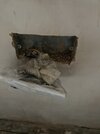Hi all,
We’ve just finished having our house plastered and the plasterer left all the sockets hanging out in a misguided attempt at being helpful.
Some of the plastering goes over the screw holes so I’m guessing needs to be cut(?) back to show the screws and the socket holes are also filled with plaster.
Clearly I’m new to DIY so I’m looking for some best practice advice of how to make sure the sockets can be screwed back in without damaging the new plaster.
P.S I will turn the sockets off at the fuse board when doing!!
Thanks in advance View attachment 300958
We’ve just finished having our house plastered and the plasterer left all the sockets hanging out in a misguided attempt at being helpful.
Some of the plastering goes over the screw holes so I’m guessing needs to be cut(?) back to show the screws and the socket holes are also filled with plaster.
Clearly I’m new to DIY so I’m looking for some best practice advice of how to make sure the sockets can be screwed back in without damaging the new plaster.
P.S I will turn the sockets off at the fuse board when doing!!
Thanks in advance View attachment 300958





